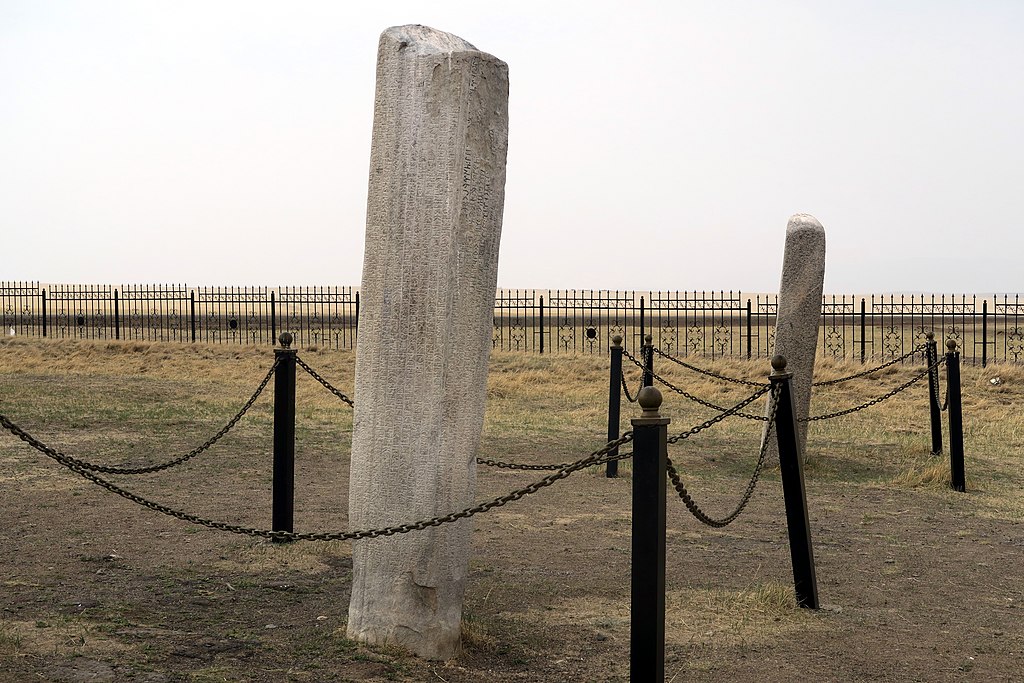(عربي) According to Wiktionary, the origin of the word Turk goes back to the word “root”, “ancestry” or “race” in the old Turkic, the language of the Orkhon inscriptions. But according to the inscriptions, it’s clear that the term isn’t used as an umbrella term for all the Turkic peoples. It might be similar to how contemporary Mesopotamian Arabic speakers use the term “Arab” when they say “our Arabs” referring to their own tribe’s area, but not exactly.
On the eastern side of the Orkhon inscriptions’ stone, Kul Tigin mentioned the Khagan of the Turuges (Türügeš): “The Tiirgish Khagan was of my Turks, my people. Because of his foolishness, and because he was filled with deceit towards us he was slain and his buyruks and begs were slain.” Which shows that the term Turks here refer to the group that is loyal to the Khagan, and that it doesn’t have a nationalistic or racial indication. Kyrgyzs, Oghuz, Kumans are peoples known to have spoken Turkic languages, but for the Orkhon inscriptions’ authors they’re not Turks.
The most common term that comes with the word Turk in Orkhon inscriptions is ‘Begs’, it always mentions ‘Turkish people and Turkish begs’. The Begs is the plural of Beg which refers to the nobles as if it is important to distinguish between the commoners and the Begs. That reminds me of the Primary Russian Chronicle which had also distinguished between people and Boyars very frequently. Ibn Iyas, from 16th century Egypt, also refer to the class of the people and doesn’t describe them as one group. That would be similar to say in today’s language: ‘the people and the managers’ or ‘people and the doctors’ or ‘the people and the rich ones’ if we wanted to separate the people based on bureaucratic, scientific, and financial elites.
The word Turk doesn’t mean Turkic people as we use it today. It doesn’t refer to those who speak Turkic languages and have common traditions and they share the same language family that is clearly different from the Chinese tradition and language, but the inscriptions continuously mentioned “Chinese, Kitays and Oghuz”. For example: “If these three—the Chinese, the Oguzes, and the Kitays—combine, all will be over with us; we are, as it were, fastened to a stone by the Will(?) of Fate”. However, short term alliances with people like the Türügeš was enough to make them “Turks” of the Khagan.
The translator adds the word “Turk” between two brackets in one of the sentences that was mentioned “westerners”, but the original text did not dub them as Turks actually, and never used that term in a context except for being the people of the Khagan. The inscription however talked about what shows how the Khagans believe about their similarity between them and the other “Turkic” peoples in today’s measures. For example, he often refers to their rulers as Khagans too, but that also not confirmed, for example “From the Tibetan Khagan came a holm”, where they called the Tibetan ruler a Khagan too. The inscription also show that those other peoples have Begs and peoples “begs and peoples of Tokuz Oguz”, but the Chinese do not have begs.
Another aspect of the identity concepts gets clarified when talking about the names and the daughters of the Turks become slaves to the Chinese, or about perishing and becoming extinct or few in numbers. “The sons of the nobles became the bondsmen of the Chinese people, their unsullied daughters became its slaves. The Turkish begs gave up their Turkish names [or titles ?], and bearing the Chinese names [titles ?] of Chinese begs they IE 8 obeyed the Chinese Emperor, and served him during fifty years”. The inscription talked about the shame of some Turks who adopted Chinese titles and how their daughters became slaves to the Chinese. But if someone had a Chinese noble title then that means they’re not actually losing their daughters freedom, but it is just a kinship relationship. The inscription on the other side accepted that the Khagan married his daughter to the Kyrgyz Khagan, and that was not a shame. Is that because of the considering the Kyrgyzs ethnically close to the Gokturks?
Finally, this is not a research about the word Turks and its meaning and evolution, but if the same concept existed among other Turkic peoples by that time, and if everyone calls his allies “Turks” then in the big Turkic conquests, like the Seljukid, probably the invaders mass was a Turkic mass in the view of the invaders, their Khagans’ and the others’. Diwan Lughat Al-Turk of Mahmood Al-Kashgari would probably be the best source about such subject.
